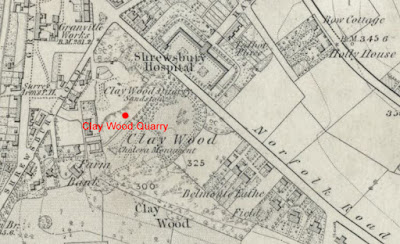 |
| A crozzle topping to a stone wall on City Road |
My walk from Letwell to Maltby, at just under 10 km, had provided some good exercise, added to my knowledge of the Permian and Quaternary geology of Rotherham and enabled me to photograph more listed buildings for the British Listed Buildings website – as well as adding another mediaeval church to a growing list of those that I had visited in South Yorkshire.
Having had such a productive day, I could easily have taken it easy for a few days but, with the sun shining the next day, I decided to spend an afternoon in Sheffield – with my main objective to see if I could obtain a piece of Silkstone Rock from the old Clay Wood Quarry, which I had noticed on the Sheffield Area Geology Trust (SAGT) website.
To make a decent walk for myself, I decided to get off the bus at the main entrance of City Road Cemetery, which is set just below the escarpment of Parkgate Rock that forms the upper part of the cemetery and Skye Edge – a prominent topographic feature that overlooks Sheffield.
Getting off the bus, I could not help but notice the 'black granite’ memorials that were displayed outside K’s Memorials, which is located directly opposite the entrance to the cemetery. The designs were not to my taste, but I was very interested in the contrast in colour between the tooled and polished surfaces.
Crossing over the road to the Grade II Listed gatehouse, I didn’t have a close look at the sandstone used here and was more interested in the Crosland Hill stone, from the Rough Rock near Huddersfield, which has been used for a series of sculptures on City Road by Ben Leach, Tom Clark and Thomas Kenrick.
Continuing down City Road, the stone wall at the entrance to the footpath to St. Aidan’s Rise caught my eye, with its top being adorned by large irregular lumps of a black material that looked remarkably like the vesicular basalt that I had seen on Mount Etna, as an undergraduate geologist more than 40 years ago.
This material is not basalt or any other kind of stone, but it is a slag that formed as a bi-product of the now obsolete process of making steel in a cementation furnace and is known in the Sheffield area as crozzle – a term also used for overcooked and blackened food, especially bacon.
Having my Estwing hammer with me, I chipped off a couple of pieces from a loose block and then carried on down City Road to look at the terraced houses, which I assumed had been built with stone from a local quarry in the Parkgate Rock. Although much of the masonry was blackened, a couple of recently cleaned houses showed the original colour and characteristics of this stone, which I hadn’t knowingly seen before.
After taking a few photos of the church of St. Aidan and St. Luke, I had a quick look at the coarse gritty sandstone that has been used in its construction, which was quite unlike that seen in the local terraced housing and is probably one of the coarse sandstones from the lower part of the Pennine Lower Coal Measures Formation in the north-west part of Sheffield.
The dressings, however, looked much paler and very uniform in colour and, on close inspection, these proved not to be sandstone, but a textured artificial stone – a reflection of the development construction materials available when it was built in 1933.
Before turning down into Granville Road, I was interested to see the dilapidated H W Roberts Memorial Works next to Lyndhurst, where surprisingly its name appears not to be carved in sandstone but is another example of artificial stone.











Another really interesting read, Scott. Interesting to learn about crozzle, too, as it's something I've seen in passing often, and a word I grew up hearing often, though only in reference to burnt food.
ReplyDeleteThanks Moaks for reading and I'm glad that it added to your local knowledge. Scott
Delete